| February 19, 2008 |  |
MoonDaily Advertising Kit |
| Previous Issues | Feb 18 | Feb 15 | Feb 14 | Feb 13 | Feb 12 |
India's Moon Mission Likely To Be Put Off To June Bangalore, India (PTI) Feb 15, 2008
Bangalore, India (PTI) Feb 15, 2008Chandrayaan-1, India's first mission to Moon, scheduled to be launched in April, is likely to be postponed to June, an Indian Space Research Organisation official said on Tuesday. The much-awaited mission was originally scheduled to be held on April nine or April 23 from India's spaceport of Sriharikota. "Now, it looks doubtful in April. We are working on a (different) PSLV mission ... more Total Lunar Eclipse Next Wednesday  Washington DC (SPX) Feb 14, 2008
Washington DC (SPX) Feb 14, 2008On Wednesday evening, February 20th, the full Moon over the Americas will turn a delightful shade of red and possibly turquoise, too. It's a total lunar eclipse-the last one until Dec. 2010. The Sun goes down. The Moon comes up. You go out and look at the sky. Observing the eclipse is that easy. Maximum eclipse, and maximum beauty, occurs at 10:26 pm EST (7:26 pm PST). A lunar eclipse ... more India to announce lunar mission date this month  Bangalore, India (AFP) Feb 13, 2008
Bangalore, India (AFP) Feb 13, 2008India will announce the date of its first lunar mission by the end of this month, the head of the country's space agency said Wednesday. A report in the Times of India Wednesday said that the launch of Chandrayaan-1, originally planned for April, had been "tentatively postponed" until June or July because of technical reasons. But Indian Space Research Organisation chairman ... more Titan's Surface Organics Surpass Oil Reserves On Earth  Laurel MD (SPX) Feb 14, 2008
Laurel MD (SPX) Feb 14, 2008Saturn's orange moon Titan has hundreds of times more liquid hydrocarbons than all the known oil and natural gas reserves on Earth, according to new Cassini data. The hydrocarbons rain from the sky, collecting in vast deposits that form lakes and dunes. The new findings from the study led by Ralph Lorenz, Cassini radar team member from the Johns Hopkins University Applied Physics Laboratory ... more Scientists Study The Plumbing Of The Enceladus Plumes  Potsdam, Germany (SPX) Feb 14, 2008
Potsdam, Germany (SPX) Feb 14, 2008Scientists on the Cassini mission have become out-of-this world "plumbers" as they try to piece together what's happening inside the "pipes" feeding the plumes of Saturn's moon Enceladus. Enceladus is jetting out giant geysers three times the size of the moon, and now scientists are beginning to understand how the ice grains are created and how they might have formed. Knowing the process ... more |
lunar
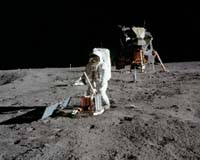 life  shuttle 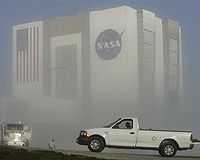 |
 Pasadena CA (JPL) Feb 06, 2008
Pasadena CA (JPL) Feb 06, 2008One of Saturn's rings does housecleaning, soaking up material gushing from the fountains on Saturn's tiny ice moon Enceladus, according to new observations from the Cassini spacecraft. "Saturn's A-ring and Enceladus are separated by 100,000 kilometers (62,000 miles), yet there's a physical connection between the two," says Dr. William Farrell of NASA's Goddard Space Flight Center in Greenbelt ... more NASA Budget Request Strong On Earth Weak On Mars  Pasadena CA (SPX) Feb 06, 2008
Pasadena CA (SPX) Feb 06, 2008Two new Earth-observing satellites, a "flagship" mission to the outer planets, and several small lunar missions are among the highlights of the Administration's budget request for NASA for fiscal year 2009. At $17.6 billion the proposal represents a 1.8% increase over NASA's actual budget for 2008, and $4.44 billion, or just over a quarter of the total, is slated towards NASA's science missions. ... more Plan Bush For Outer Space Facing Critical Open Source Review  Los Angeles CA (SPX) Feb 04, 2008
Los Angeles CA (SPX) Feb 04, 2008Scientists and space policy experts say they will debate whether President George Bush's call for a return to the moon and voyage to Mars is feasible. Hundreds of millions of dollars were spent the last four years to design, build and test spacecraft in the program dubbed Constellation, The Washington Post reported Saturday. The program, however, has not caught the public's imagi ... more NASA Issues Environmental Impact Statement For Constellation  Washington DC (SPX) Jan 31, 2008
Washington DC (SPX) Jan 31, 2008NASA issued an environmental impact statement for the Constellation Program Jan. 10. NASA's Constellation Program is developing a space transportation system that is designed to return humans to the moon by 2020. The Final Programmatic Environmental Impact Statement concludes that localized and global environmental impacts associated with implementing the program would be comparable to past or ... more |
spacetravel
 asteroid 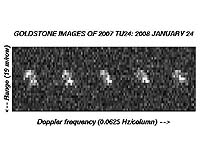 jupiter  |
 Pasadena CA (SPX) Jan 28, 2008
Pasadena CA (SPX) Jan 28, 2008Scientists at NASA's Jet Propulsion Laboratory in Pasadena, Calif., have obtained the first images of asteroid 2007 TU24 using high-resolution radar data. The data indicate the asteroid is somewhat asymmetrical in shape, with a diameter roughly 250 meters (800 feet) in size. Asteroid 2007 TU24 will pass within 1.4 lunar distances, or 538,000 kilometers (334,000 miles), of Earth on Jan. 29 at 1 ... more Volcanic deposits may aid lunar outposts  Washington (UPI) Jan 23, 2007
Washington (UPI) Jan 23, 2007 A U.S. study of radar images of the moon suggests deposits from early lunar volcanoes might be useful to astronauts at lunar stations. Bruce Campbell and associates at the National Air and Space Museum said ancient volcanic eruptions on the Moon produced deposits of fine-grained, often glass-rich, pyroclastic material. In some places, such as at the Aristarchus Plateau, the deposits can ... more NG-Built Antennas Helping Provide Data On Moon's Thermal History For Japan's KAGUYA (SELENE) Mission  Carpenteria CA (SPX) Jan 23, 2008
Carpenteria CA (SPX) Jan 23, 2008Four specialized antennas built by Northrop Grumman Corporation for the Japanese Aerospace Exploration Agency (JAXA) are functioning as expected after deploying successfully onboard the SELenological and ENgineering Explorer "KAGUYA" (SELENE), Japan's first large lunar explorer. The four dipole antennas deployed to their 15-meter (49.5 feet) full design length Oct. 31. Manufactu ... more Near-Earth Asteroid 2007 TU24 To Pass Close To Past Earth On Jan 29  Pasadena CA (SPX) Jan 23, 2008
Pasadena CA (SPX) Jan 23, 2008Asteroid 2007 TU24, discovered by the Catalina Sky Survey on October 11, 2007 will closely approach the Earth to within 1.4 lunar distances (334,000 miles) on 2008 Jan. 29 08:33 UT. This object, between 150 and 600 meters in diameter, will reach an approximate apparent magnitude 10. 3 on Jan. 29-30 before quickly becoming fainter as it moves further from Earth. For a brief time the asteroid wi ... more
|
lunar
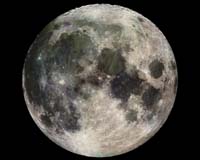 solarscience 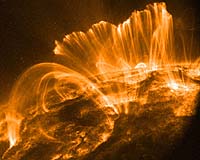 lunar 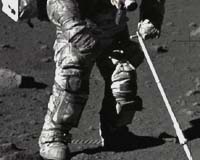 |
| Previous Issues | Feb 18 | Feb 15 | Feb 14 | Feb 13 | Feb 12 |
| The contents herein, unless otherwise known to be public domain, are Copyright 1995-2007 - SpaceDaily. AFP and UPI Wire Stories are copyright Agence France-Presse and United Press International. ESA Portal Reports are copyright European Space Agency. All NASA sourced material is public domain. Additional copyrights may apply in whole or part to other bona fide parties. Advertising does not imply endorsement, agreement or approval of any opinions, statements or information provided by SpaceDaily on any web page published or hosted by SpaceDaily. Privacy statement |